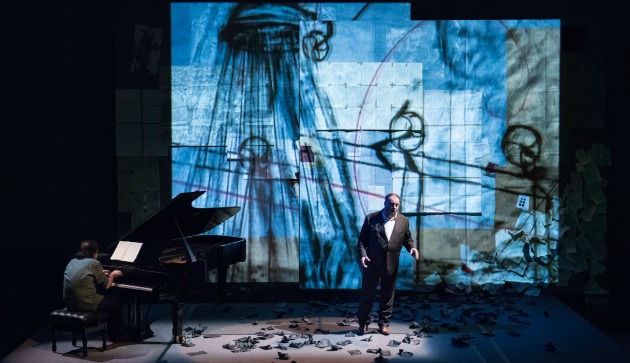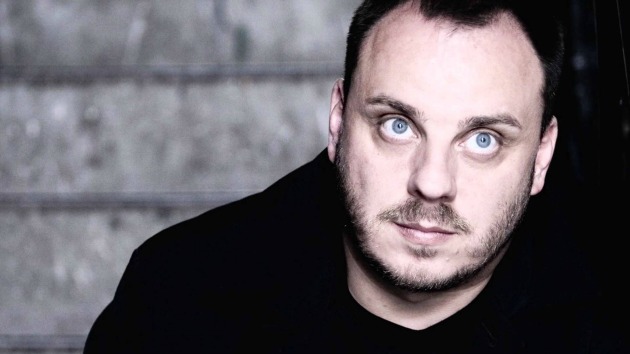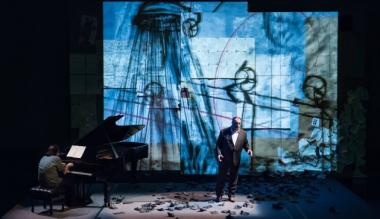
“This is an experiment,” both San Francisco Opera General Director, David Gockley, and SF Opera Lab. Director of Programming, Elkhanah Pulitzer announced at the official opening of the new Opera Lab season in the new 299-seat Dianne and Tad Taube Atrium Theater in San Francisco’s Diane B. Wilsey Center for Opera.
The event, staged three floors above Herbst Theater in what was formerly a high-ceilinged, columned and domed gallery of the San Francisco Museum of Art, saw the great baritone Matthias Goerne, marvelously supported by pianist and Salzburg Festival artistic director Markus Hinterhäuser, performing Franz Schubert’s Winterreise (Winter’s Journey), to animated films by South African visual artist William Kentridge.
Gockley’s emphasized that “Everybody is trying new things; everyone is trying find what works, and what will bring in a younger audience.” It’s not clear that the majority of song lovers share his assessment that “the traditional song cycle concert has lost its appeal.” Even if they had attended Goerne’s previous Winterreises in Herbst and Davies Symphony Hall, however, they turned out in force for this anything-but-traditional, 80-minute, dimly lit happening, in which the artists hoped to supplant the need for printed or projected translations of Wilhelm Müller’s 24, overwhelmingly bleak poems.
This animated Winterreise, which was successfully premiered in 2014 at the Festival d’Aix-en-Provence, and then reprised the following season, has also made its mark at the Lincoln Center for the Performing Arts and festivals/theaters in Vienna, Holland, Hanover, Luxembourg, and Lille. Which is not to say that the art of Kentridge is a perfect match for Schubert’s music and Müller’s texts.
Kentridge makes clear in his program notes that the excerpts from his many films, although re-contextualized with new titles and images appropriate to Winterreise, are recycled, and that the connections are as much rhythmic and iconic as they are textual. But such a highly personal approach leaves the audience out, where working to elucidate the meanings of songs would have been more inclusive.
Hence we ended up with images, projected onto an imaginative backdrop by Sabine Theunissen, that were often not an easy fit. To take but one example, Kentridge’s animation for the final song, “Der Leiermann” (The Organ Grinder), used silhouettes of African women and men slowly and rhythmically processing along a barren, black and white, arid landscape. Meanwhile, we pondered Goerne and Hinterhäuser’s interpretation of this intentionally enigmatic song, which some have conceived as a death-throw hallucination, others (including Goerne in Davies) as a final sign of madness, and yet others (Jonas Kaufmann) as an indication that the journey will continue. Those who were able to transcend the disconnect and surrender to artistic license and a unifying rhythm, or who closed their eyes without remorse certainly had an easier time of it than those who chose to try to figure it all out, or, heaven forbid, resist.
I spent at least three or four songs with eyes closed. Doing so, I found Goerne and Hinterhäuser’s intensity of focus unparalleled in my experience.

Goerne’s huge range of colors and dynamics bespoke a total identification with music and words. In a Winterreise whose unifying factor was one of rejection and despair rather than madness, the supremely lyrical manner with which he voiced his grief felt utterly natural. Every sound and gesture, from tender confession to fury and bitterness, seemed as if created in the moment, as if a personal response to the situation at hand. The performance was fully lived.
Perhaps the sense of musical spontaneity that emerged was as much Goerne’s unease with the absurdly artificial acoustic of the Meyer Sound Constellation sound reinforcement system as anything else. Every time the baritone turned around to face the projections, swelled from soft to loud, took a few steps, or leaned over the piano, his voice sounded as if it was projected into an echo chamber. Even when he sang at even volume, the entire resonant envelope changed dramatically with the simplest movements. Schubert’s landscape may be frozen, but the way the electronics required Goerne to restrict his natural movements was preposterous.
In a private exchange after the performance, the baritone complained that the acoustic was so artificial that whenever he shifted beyond a small square, all resonance around his voice vanished, and the acoustic around him collapsed. Such an environment militates against artists performing at their best.
Despite that ridiculous impediment, all parties spoke with the deepest artistic integrity. Goerne’s vocal beauty, powerful surges, and love for music that addresses the most profound questions facing humanity were moving, and Hinterhäuser was his eloquent partner. The ultimate tribute to Goerne’s genius was that, despite the handicap, he performed with such soul-touching power.

